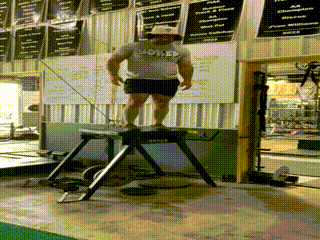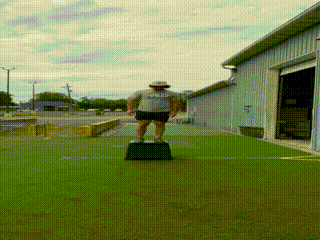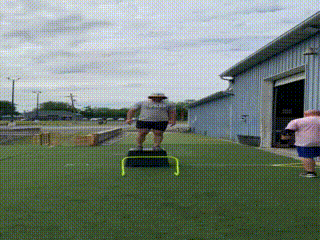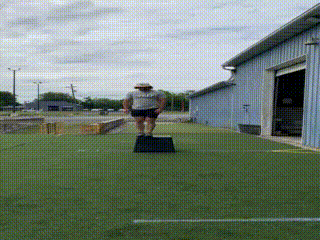Depth Jump
Depth Jump Explained - A Simple Movement with Explosive Results
Plyometrics are some of the best styles of exercises in existence for increasing speed, becoming more explosive, and enabling athletes to accelerate. Box jumps, hurdle hops, and stair jumps are all perfect examples of plyometric exercises that have a big impact on athleticism.
One thing people at times will discount is the landing forces involved in plyometric movements. Exercises like the box jump and stair jump, as great as they are, eliminate much of the eccentric force that body weight and gravity bring to the table.
In many respects, not having the more impactful landing showcases some of the benefits of stair jumps and box jumps, and how they can be programmed to lessen intensity and help with athlete recovery because less sheer forces are occurring.
On the other hand, the lesser landing forces needed don’t put as much upon the body. A plyometric exercise like the hurdle hop, a stable plyometric exercise in our strength training app, Peak Strength, because of the higher landing forces from the full height of the jump to the ground requires more force production to decelerate and accelerate back into the next jump. It’s physics.
When it comes to resisting gravity in a plyometric setting, the depth jump takes the biggest piece of cake.
Plyometrics
Plyometric exercises are explosive movements. They are jump centric movements that are done on two legs and one leg. Plyometrics can be done with implements, like boxes, hurdles, and stairs, or without implements.
Many plyometric exercises can be done with absolutely zero equipment. Body weight and some open space, preferably level and flat, is all that is needed to perform many plyometric exercises.
No equipment needed, bodyweight plyometrics include movements like skips for distance, skips for height, bounds for distance, bounds for height, broad jumps, vertical jumps, tuck jumps, pogo jumps, and a Garage Strength exclusive, champion strides.
The simplistic nature of performing plyometrics is one of their greatest values for a cash strapped athlete. This isn’t to say that having equipment isn’t beneficial, just that not having any equipment doesn’t gatekeep the ability to perform plyometric exercises. And even many of the movements that do use equipment, like box jumps and stair jumps, publicly available substitutes can be located with outside staircases and objects of various heights that can be landed on.
Plyometric movements require the rate of force production to be high. Athletes performing plyometrics must rapidly contract lower body musculature in coordination with the upper body and explode in either single rep movements or multiple repetitions of successive jumps.
The impact on athleticism brought by plyometrics is monumental. Performance of plyometrics will transform an athlete’s ability to jump higher, run faster, and be quicker out of cuts.

Depth Jump Explained
As a kid I used to love swinging on the school yard swings. I’d try to see how high I could get myself to swing. Being young and in elementary school, I felt like I was super high.
Being quite the risk taker and wanting to have the feeling of flying, I’d jump off the swing at its highest point when recess ended. The momentum of the swing would launch me higher into the air and I’d come crashing down to the ground with extreme forces, landing with both legs.
I didn’t know it at the time, but this was one of my initial experiences with plyometrics and depth jumps.
The depth jump is a specific type of plyometric exercise. At its core, the depth drop is about deceleration and absorbing force.
To perform a depth jump, an athlete steps off a height and lands. Typically, the object being stepped off of is a box.
There is no need to jump off the box, but simply step. The goal is the landing. Athletes don’t want to be bottoming out when they land. Meaning their butt cheeks are touching their Achilles.
The depth jump is an extreme eccentric force, depending on the height being jumped from.
With the depth jump, athletes can vary the height and whether they land on one foot or two feet. Unilateral braking power and bilateral braking power are great skill sets for athletes to possess.
The height of the depth jump is another matter. To begin, the height does not need to be extreme to get results, especially depending on what the athlete is being asked to do after the depth jump. If the athlete is being asked only to land, the height of the depth jump plays a bigger role in the sought after adaptation. If the athlete is being asked to perform another movement after the depth jump, like a hurdle hop or broad jump, the means of obtaining the adaptation now has more variables at play and changes the shape of things.

Depth Jump Variations
At its core, the depth jump is jumping from a height and landing.
But that is not all a depth jump needs to be.
Depth Jump to Broad Jump
One excellent variation of the depth jump is to perform a depth jump to broad jump.
Believe it or not, but the depth jump helps load the muscles and will often initiate a farther broad jump. Through the depth drop, there is some type of greater elastic engagement from the lower limbs that makes for a twitchier broad jump.
First off, the depth drop in this variation does not need to be from any extraordinary height. Athletes can depth drop from as low as 8” or as high as 20” and get all the elastic loading they need. I’d caution that 20” is even a bit high for such a movement.

Depth Jump to Hurdle Hop
Where the depth jump to broad jump has athletes absorbing a vertical force and redirecting it into a horizontal force, the depth jump to hurdle hop asks the athlete to take a vertical landing force and reapply force to move both vertical and horizontal.
The hurdle hop itself has a depth drop component latent within the landing. Remembering back to the beginning of the blog, this is why movements like box jumps and stair jumps are slightly less intense on the body from the higher landing, giving gravity less time to do its thing.
Again, the depth drop does not need to be that high, 8” to 20” is applicable.

Depth Jump to Pogo Jump
The depth jump to pogo jump is great for absorbing the downward forces of the body and gravity and turning them into vertical forces.
Using the depth jump to pogo jump is great for the soleus muscle and helps develop the needed elasticity seen in speedy athletes.
The ability to slam on the brakes and quickly accelerate in a direction is a pivotal skill for all athletes.
Depth Jump to Heiden Jump
The Heiden jump is a single leg jump in which an athlete jumps side to side. The athlete will jump off their right leg, propelling their body horizontally to the left, and then land on their left leg. The Heiden jump can be done the opposite way too.
Instead of starting the movement from the ground, start the Heiden jump with a depth drop. In this variation, the depth drop landing must be done on a single leg and the horizontal force is now having the body project to the side, whereas with the depth drop to broad jump, the horizontal force is projecting the body forward.
The single leg movement into a side jump is awesome for training change of direction, deceleration, and agility.

When To Use It
The depth drop and the depth drop variations are intense movements. The depth drop ups the starting intensity on any plyometric movement it is paired with.
That in mind, the depth drop is great to use when athletes training intensity is ramping up within their periodization. In the same breath, when intensity and touches on the ground need to be lessened, depth drops aren’t necessarily ideal to be included.
With the Garage Strength Program Design methodology, athlete day (which is in Peak Strength) is the best time to use depth drops within a training week.
Athlete day is a training day that is plyometric focused. Nearly every exercise is a plyometric movement. The point is to have athletes move like athletes. Be explosive. Be twitchy. Be elastic. That’s athlete day in a nutshell.
When using depth jumps and depth jump variations, athlete day is where it's at for fitting it into a weekly training schedule.
Sample Athlete Day Workout (Depth Jump Focus)


The Bottom Line
The depth jump is a primal movement. Kids on playgrounds jumping off swings perform this exercise daily. It makes for extreme eccentric forces and teaches the body how to slam on the brakes to improve strength and deceleration capabilities.
Where the depth jump has its detractors, it also has its ardent believers. The depth jump is infinitely scalable. It can be done from great heights (think near 100 inches) to closer to the ground (think 6 inches). Both have positives and both have negatives, but both manners of executing the depth jump have effective carryover to improving athleticism.
So if you’re an athlete looking to train using the depth jump, or any plyometric for that matter, head over to peakstrength.app and download Peak Strength our strength training app developed with athletes in mind so you can reap the benefits of the athlete day and all the various plyometrics that will make you faster, more explosive, and quicker.
Later.


EARL KUNKEL
3x World Champion Co-Author of the Year
King of the PA Press
Blog Topics

Yo, It's Dane
Welcome to the Garage Strength Blog, where it is my goal to provide you with the experience and knowledge I've gained in the strength and conditioning world over many years of learning from both successes and failures. I train elite-level athletes in a multitude of sports from the high school to professional levels, already producing 5 Olympics and 30+ National Champions. If you want to be the next champion I train, check out my strength programs below!
Start Training With Me

Join for free educational videos EVERY WEEK on strength coaching and athletic performance

